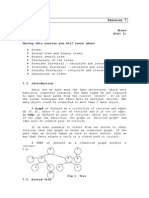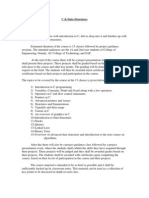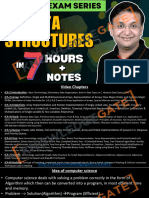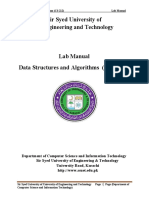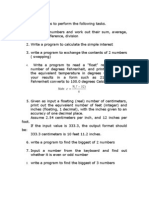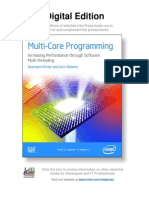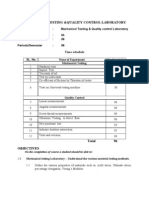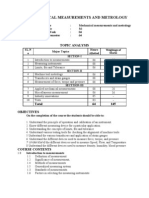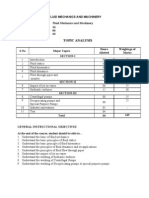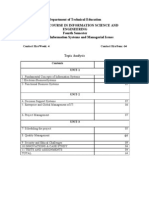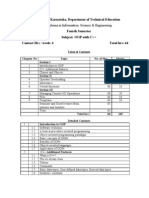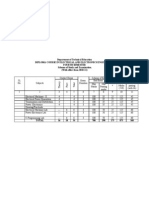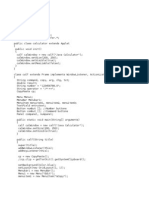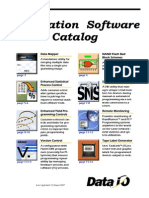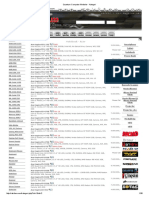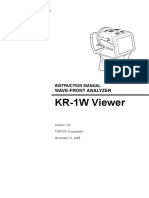Data Structures Using C
Uploaded by
Vikram RaoData Structures Using C
Uploaded by
Vikram RaoGovt.
of Karnataka, Department of Technical Education Diploma in Information Science & Engineering Third Semester Subject: DATA STRUCTURES USING C Contact Hrs / week: 4 Table of Contents
Chapter No 1 2 3 4 5 6 7 8 9 10 Topic Section I Pointers Dynamic Memory allocation Files Section II Introduction to data structures The Stack Queues Section III Linked lists Trees Sorting Searching Seminars and Guest lectures from Industry and Institute Tests Total hrs No. of Hrs 08 04 06 02 08 06 08 06 06 02 05 03 64 145 Marks 18 6 14 4 22 14 20 16 15 6
Total hrs: 64
Detailed Contents
1 1.1 1.2 1.3 1.4 1.5 1.6 1.7 1.8 1.9 1.10 2 2.1 2.2 2.3 Pointers Concept of pointers Declaring and initializing pointers Accessing variables using pointers Pointer arithmetic Pointers and arrays Pointers and character strings Pointers and functions Pointer as a function argument Pointers to function pointers and structures Dynamic Memory allocation Introduction Dynamic memory allocation Allocating a block of memory : Malloc
2.4 2.5 2.6 3 3.1 3.2 3.3 3.4 3.5 3.6 3.7 4 4.1 4.2 4.3 4.4 5 5.1 5.2 5.3 5.4 5.5 5.6 5.7 5.8 5.9 5.10 5.11 5.12 5.13 5.14 6 6.1 6.2 6.3 6.4 7 7.1 7.2 7.3 7.4 7.5 7.6 7.7 7.8 8 8.1 8.2
Allocating multiple blocks of memory : Calloc Releasing the used space : Free Altering the size of memory : Realloc Files Introduction Defining and opening a file Closing a file Input / Output operations on files Error handling during I/O operations Random Access to files Command line arguments Introduction to data structures Introduction Data and information Types of data structures Primitive & non primitive data structures ND operations The Stack Definition and examples Primitive Operations- Push and Pop Representing Stacks in C Implementing Push and Pop Operations in C Applications of Stacks Infix, Postfix and Prefix Expressions Algorithm for evaluating an expression- Infix to prefix, Infix to Postfix Recursion Recursive definition Multiplication of Natural numbers Factorial Function GCD function Properties of Recursive algorithms/functions Recursion in C Queues The queue and its sequential representation C implementation of Queues and their operations C implementation of Circular queues and their operations Dequeue and priority queues(Concepts only) Linked lists Linked linear lists Inserting and removing nodes from a list Linked Implementation of Stacks and Queues Array implementation of lists in C and its limitations Linked list using dynamic variables in C Comparing the Dynamic and Array Implementation of Lists Circular linked lists (Concepts only, no implementations) Doubly linked list Trees Introduction Basic Terms
8.3 8.4 8.5 8.6 8.7 9 9.1 9.2 9.3 9.4 9.5 9.6 9.7 9.8 9.10 9.11 10 10.1 10.2 10.3 10.4
Binary trees Complete binary tree Binary tree representation Operation on binary tree Traversal of a binary tree Sorting Exchange sorts --Bubble sort --Quick sort (No implementation) Selection and tree sorting --Straight selection sort --Binary tree sort Insertion Sorts --Simple Insertion sort --Shell sort (No implementation) Merge sort and Radix sort (No implementation) Searching Introduction Searching Linear (sequential) search (without creating linked list) Binary search
General objectives: 1 Understand the concept of pointers and their operations 2 Understand the concept of dynamic memory allocation 3 Understand file handling in C Know the concepts of linear data structures, their operations and 4 applications Know the concepts of non linear data structures, their operations and 5 applications 6 Understand the various sorting and searching techniques Specific Objectives: Pointers Bring out the concepts of pointers Learn to declaring and initializing pointers Learn to access variables using pointers Explain the concepts of pointer arithmetic Explain the use of Pointers in arrays, character strings, functions, structures Files Define File Learn the I/O operations on files Distinguish between sequential & random access files
Learn to handle errors in files and command line arguments Introduction to data structures Define Information ,data and data structures Distinguish between the various types of data types: primitive and non primitive Define stack with examples Explain the Primitive Operations- Push and Pop performed on stack Write programs to Implement Push and Pop Operations in C Learn the applications of Stacks Learn about Infix, Postfix and Prefix Expressions Learn to convert expressions i.e. from Infix to postfix & prefix, Learn to convert Postfix to infix & prefix ,Prefix to infix & postfix Expressions Understand recursion: eg. Multiplication of natural numbers, Factorial and GCD Learn queue with examples and their sequential representation Learn C implementation of Queues and their operations Learn C implementation of Circular queues and their operations Learn the concepts of Dequeue and priority queues Linked list Learn the concepts of Linked linear lists, their advantages and disadvantages Write programs for Inserting and removing nodes from a list Write programs to implement of Stacks and Queues Learn Array implementation of lists in C and its limitations Implement Linked list using dynamic variables in C Examples of list operations in C Comparing the Dynamic and Array Implementation of Lists Learn concepts of Circular & doubly linked lists Trees Define Binary trees and learn their concepts Understand tree operations Learn & implement binary tree traversal operations Sorting To understand different sorting Techniques with examples To implement sorting techniques in C Searching To understand linear and binary search Techniques with examples To learn and implement linear and binary search techniques in C Text book: 1. For Chapter 1 to 3 -- Programming in ANSI C, E.Balagurusamy, 4E, Tata McGraw Hill, ISBN: 9780070648227 2. For Chapters 5, 6, 7, 9,10 -- DATA STRUCTURES USING C AND C++, Langsam yedidyah, Augenstein moshe j., Aron M. Tenenbaum , Second Edition, PHI 3. For Chapters 4 and 8 -- Introduction to Data Structures in C, Ashok N Kamthane, Third impression 2009, Pearson Education, ISBN : 9788131713921
Reference Books: 1. C and data Structures, Dr.N.B. Venkateshwarulu and Dr.E.V Prasad, S chand Publications 2. Data structures Using C, Aron M. Tenenbaum ,langsam yedidyah, Augenstein moshe j. , PHI 3. C and Data Structures, Prof. P S Deshapande and Prof. O G Kakde
Govt. of Karnataka, Department of Technical Education
Diploma in Information Science & Engineering Third Semester Subject: Data Structures using C Max. Marks: 100 Model Question Paper Note: 1. Section I is compulsory. 2. Answer any TWO questions from each remaining Sections. Marks Section I 1. a) Fill in the blanks with appropriate word/s i. is a variable which holds the address of another variable. ii. . is an example for non linear data structure iii. The process of a function calling itself is called iv. . is used to open a file. v. The total number of nodes in a complete binary tree is given by .. b) Write a note on Command line arguments. Section II 2. a) Define Pointer. Explain pointer arithmetic. b) Differentiate between call by value and call by reference parameter passing techniques with example. 3. a) Write a program to sort N numbers using malloc( ) . b) Define File and explain different File modes. c) How to handle errors in files? 4. a) Distinguish between linear and non linear data structure. b) Write an algorithm to perform PUSH and POP operations in Stack. Section III 9 6 6 3 5 10 6 5 5x1=5 Max. Time: 3 Hours
5. a) What is recursion ? Explain with an example. b) Convert the following expressions to postfix i. (A + B) * (C - D) $ E * F ii. ((A (B + C) * D) $ (E + F) c) Define Queue. 6. a) Write a program to implement Circular Queues in C b) Write a note on Priority queues. 7. a) Write an algorithm to insert a node into a linked list. b) Compare the Dynamic and Array Implementation of Lists.
7 6
2 10 5 8 7
Section IV 8. a) Explain Doubly linked list. b) Write the tree traversal algorithms. 9. a) Construct the binary tree for the following data 15,4,8,9,2,13,1,6,10,11,14 b) Write a program to implement simple insertion sort and trace with an example. 10. a) Explain tree sorting with an example. b) Write a program to perform binary search using recursion. 10 8 7 5 10 5
You might also like
- 3rd Sem CS & Is Electronic Circuits Notes (5 Chapters) .0% (2)3rd Sem CS & Is Electronic Circuits Notes (5 Chapters) .323 pages
- Data Structures Using C and C Langsampdf Ebook andNo ratings yetData Structures Using C and C Langsampdf Ebook and2 pages
- Data Structures Using C - Jagtap, Mali, 2022No ratings yetData Structures Using C - Jagtap, Mali, 2022363 pages
- Don't Overprep Coding Interviews.: For YourNo ratings yetDon't Overprep Coding Interviews.: For Your24 pages
- C Programming Language Interview Questions and With Answers PDF Download - C Interview0% (1)C Programming Language Interview Questions and With Answers PDF Download - C Interview9 pages
- C Programming Interview Questions PDF DownloadNo ratings yetC Programming Interview Questions PDF Download6 pages
- MCSE 204: Adina Institute of Science & TechnologyNo ratings yetMCSE 204: Adina Institute of Science & Technology16 pages
- Programming and Data Structures: Debasis SamantaNo ratings yetProgramming and Data Structures: Debasis Samanta63 pages
- KCS301 Data Structure UNIT 3 Searching Sorting HashingNo ratings yetKCS301 Data Structure UNIT 3 Searching Sorting Hashing61 pages
- Lab Manual: Data Structures and Applications Laboratory Manual (17CSL38) (Iii Semester)No ratings yetLab Manual: Data Structures and Applications Laboratory Manual (17CSL38) (Iii Semester)50 pages
- Barbara Liskov, Programming With Abstract Data Types100% (1)Barbara Liskov, Programming With Abstract Data Types10 pages
- Data Structures Part - A (Shortanswer Questions) : Vemu Institute of TechnologyNo ratings yetData Structures Part - A (Shortanswer Questions) : Vemu Institute of Technology6 pages
- Multi-Core Programming Digital Edition (06!29!06)No ratings yetMulti-Core Programming Digital Edition (06!29!06)362 pages
- Character Recognition Systems: A Guide for Students and PractitionersFrom EverandCharacter Recognition Systems: A Guide for Students and PractitionersNo ratings yet
- How to Design Optimization Algorithms by Applying Natural Behavioral PatternsFrom EverandHow to Design Optimization Algorithms by Applying Natural Behavioral PatternsNo ratings yet
- Mechanical Testing & Quality Control Lab100% (1)Mechanical Testing & Quality Control Lab4 pages
- PepsiCo S Op Using Sap Apo at Pepsico PDFNo ratings yetPepsiCo S Op Using Sap Apo at Pepsico PDF17 pages
- So, You Want To Learn Artificial Intelligence. Here's How You Do ItNo ratings yetSo, You Want To Learn Artificial Intelligence. Here's How You Do It23 pages
- Delivered Wednesday 12/06/2019 at 14:42: Ship Track Manage My Account Customs Tools LearnNo ratings yetDelivered Wednesday 12/06/2019 at 14:42: Ship Track Manage My Account Customs Tools Learn2 pages
- Fundamentals of Microwave Communication 1No ratings yetFundamentals of Microwave Communication 125 pages
- Syllabus Ideas For A 15-Week Digital Entrepreneurship CourseNo ratings yetSyllabus Ideas For A 15-Week Digital Entrepreneurship Course6 pages
- A Statistician Plays Darts: Ryan J. Tibshirani Andrew Price Jonathan TaylorNo ratings yetA Statistician Plays Darts: Ryan J. Tibshirani Andrew Price Jonathan Taylor15 pages
- 8 Class Computer Science (Session 2022-23) : Que:1 Fill in The BlanksNo ratings yet8 Class Computer Science (Session 2022-23) : Que:1 Fill in The Blanks2 pages
- LTM Fundamentals Exercise Guide - Partners - V13.0.KNo ratings yetLTM Fundamentals Exercise Guide - Partners - V13.0.K193 pages
- Computer Network - CS610 Power Point Slides Lecture 18No ratings yetComputer Network - CS610 Power Point Slides Lecture 1815 pages
- 3rd Sem CS & Is Electronic Circuits Notes (5 Chapters) .3rd Sem CS & Is Electronic Circuits Notes (5 Chapters) .
- Data Structures Using C and C Langsampdf Ebook andData Structures Using C and C Langsampdf Ebook and
- C Programming Language Interview Questions and With Answers PDF Download - C InterviewC Programming Language Interview Questions and With Answers PDF Download - C Interview
- KCS301 Data Structure UNIT 3 Searching Sorting HashingKCS301 Data Structure UNIT 3 Searching Sorting Hashing
- Lab Manual: Data Structures and Applications Laboratory Manual (17CSL38) (Iii Semester)Lab Manual: Data Structures and Applications Laboratory Manual (17CSL38) (Iii Semester)
- Barbara Liskov, Programming With Abstract Data TypesBarbara Liskov, Programming With Abstract Data Types
- Data Structures Part - A (Shortanswer Questions) : Vemu Institute of TechnologyData Structures Part - A (Shortanswer Questions) : Vemu Institute of Technology
- Multi-Agent Machine Learning: A Reinforcement ApproachFrom EverandMulti-Agent Machine Learning: A Reinforcement Approach
- Character Recognition Systems: A Guide for Students and PractitionersFrom EverandCharacter Recognition Systems: A Guide for Students and Practitioners
- How to Design Optimization Algorithms by Applying Natural Behavioral PatternsFrom EverandHow to Design Optimization Algorithms by Applying Natural Behavioral Patterns
- So, You Want To Learn Artificial Intelligence. Here's How You Do ItSo, You Want To Learn Artificial Intelligence. Here's How You Do It
- Delivered Wednesday 12/06/2019 at 14:42: Ship Track Manage My Account Customs Tools LearnDelivered Wednesday 12/06/2019 at 14:42: Ship Track Manage My Account Customs Tools Learn
- Syllabus Ideas For A 15-Week Digital Entrepreneurship CourseSyllabus Ideas For A 15-Week Digital Entrepreneurship Course
- A Statistician Plays Darts: Ryan J. Tibshirani Andrew Price Jonathan TaylorA Statistician Plays Darts: Ryan J. Tibshirani Andrew Price Jonathan Taylor
- 8 Class Computer Science (Session 2022-23) : Que:1 Fill in The Blanks8 Class Computer Science (Session 2022-23) : Que:1 Fill in The Blanks
- LTM Fundamentals Exercise Guide - Partners - V13.0.KLTM Fundamentals Exercise Guide - Partners - V13.0.K
- Computer Network - CS610 Power Point Slides Lecture 18Computer Network - CS610 Power Point Slides Lecture 18



